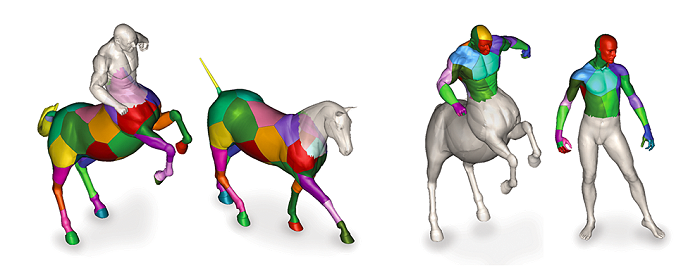|
Partial similarity and correspondence

Visualization of corresponding similar parts in centaur, horse, and human shapes.
Similarity is one of the most important abstract concepts in human perception of the world. In computer vision, numerous applications deal with comparing objects observed in a scene with some a priori known patterns. Often, it happens that while two objects are not similar, they have large similar parts, that is, they are partially similar. An excellent example are mythological half-horse half-human centaurs: they are neither human nor equine, but have similar parts with humans and horses.
We developed an approach of quantifying partial similarity of two objects as a multicriterion optimization on similarity and significance of the matching parts. Optimal matching achieves optimal tradeoff in the sense of Pareto optimality.
This formulation is generic and allows incorporating different criteria of similarity and significance, depending on the problem. For example, statistics of parts and their regularity can be used to define significance.
Our approach can be used in problems of recognizing non-rigid geometric objects, images, and analyzing text sequences.
Papers
A. M. Bronstein, M. M. Bronstein,
"Regularized partial matching of rigid shapes",
Proc. European Conf. Computer Vision (ECCV), pp. 143-154, 2008.
A. M. Bronstein, M. M. Bronstein,
"Not only size matters: regularized partial matching of nonrigid shapes",
Proc. Workshop on Nonrigid Shape Analysis and Deformable Image Alignment (NORDIA), 2008.
A. M. Bronstein, M. M. Bronstein, A. M. Bruckstein, R. Kimmel,
"Partial similarity of objects, or how to compare a centaur to a horse", Intl. Journal of Computer Vision (IJCV), Vol. 84/2, pp. 163-183, 2009.
A. M. Bronstein, M. M. Bronstein, Y. Carmon, R. Kimmel,
"Partial similarity of shapes using a statistical
significance measure", IPSJ Trans. Computer Vision and Application, Vol. 1, pp. 105-114, 2009.
A. M. Bronstein, M. M. Bronstein, A. M. Bruckstein, R. Kimmel,
"Analysis of two-dimensional non-rigid shapes", Intl. Journal of Computer Vision (IJCV), Vol. 78/1, pp. 67-88, June 2008.
A. M. Bronstein, M. M. Bronstein, A. M. Bruckstein, R. Kimmel, "Paretian similarity for partial comparison of non-rigid objects", Proc. Conf. on Scale Space and Variational Methods in Computer Vision, pp. 264-275, 2007.
See also
Symmetry and structure of deformable shapes
Non-rigid shape similarity and correspondence
|
